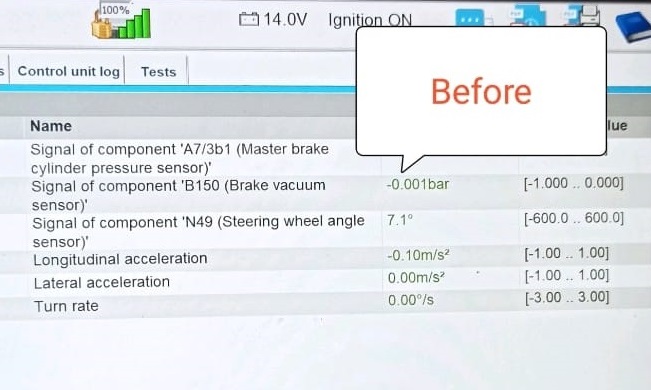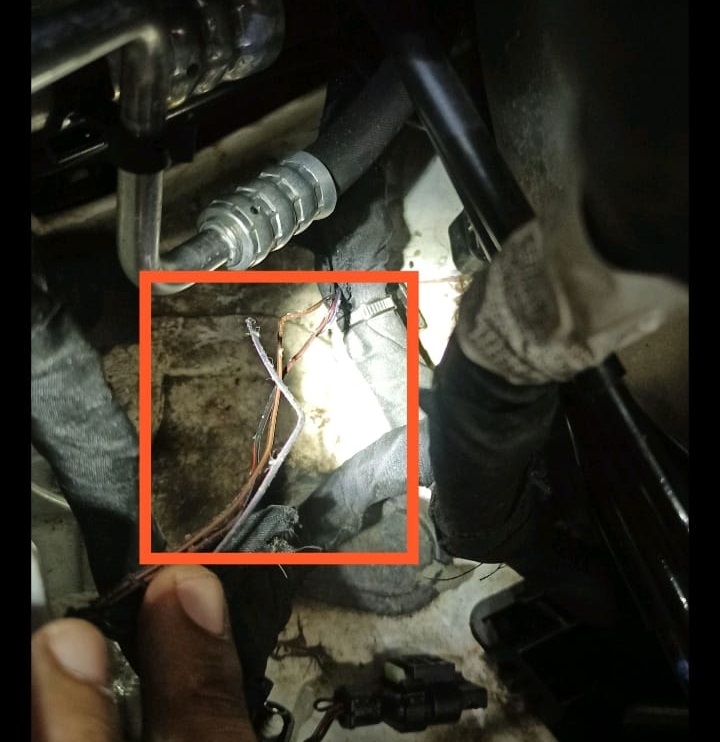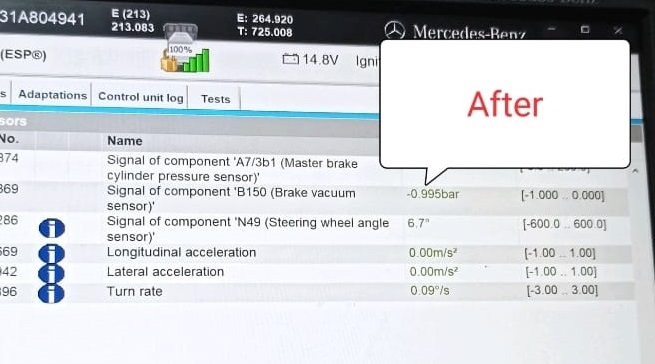Table of Contents
Yellow Brake Warning Light: Causes, Diagnosis & Fix in Mercedes-Benz E-Class W213 (M264 Engine)
Seeing the yellow brake warning light on your Mercedes-Benz dashboard can instantly raise concern. Is it safe to drive? Does it mean brake failure? While this warning isn’t as urgent as a red brake alert, it signals an issue within the brake or stability system that must be checked before it worsens.
In this real-world case study involving a Mercedes-Benz E-Class W213 equipped with the M264 Engine, we’ll walk you through the diagnosis, root cause, and repair process that resolved the issue offering practical insights you can apply to similar brake system warnings.
🔗 Related guide: Learn more about Mercedes Brake System Problems: ABS, ESP & Brake Assist Guide your complete reference for diagnosing brake faults like ABS, ESP, and Active Brake Assist issues

Initial Diagnostics and Fault Identification
Upon arrival, the vehicle was connected to Mercedes STAR Diagnosis (XENTRY) for a full system scan.
A current fault was found in the Electronic Stability Program (ESP) relating to the brake vacuum sensor (B150):
- – Fault Code: U013DFF; Communication with brake vacuum sensor has a malfunction

The actual value from the brake vacuum sensor was recorded at –0.001 bar, far outside the normal range confirming an abnormal pressure reading and a likely sensor malfunction.

Detailed Diagnostic Steps
To confirm the fault, the following tests were performed using wiring diagrams and multimeter measurements:
- 1. Power Supply Check (B150 Brake Vacuum Sensor)
The sensor’s power supply was verified and found within normal parameters eliminating voltage drop or fuse issues. - 2. Signal Voltage Measurement
Signal output from the sensor showed incorrect readings, confirming the sensor was not communicating properly with the ESP control unit. - 3. Communication & Wiring Inspection
Tracing the harness between the brake vacuum sensor (B150) and ESP control unit (N30/4) revealed rodent damage. The chewed wiring caused intermittent signal loss, triggering the yellow brake warning.

Repair & Corrective Actions
Harness Repair
All damaged wire sections were replaced and soldered using heat-shrink insulation to restore signal integrity. Connections were verified against OEM resistance values.
System Reassembly & Verification
After reassembling the harness and sensor, all components were resecured according to manufacturer torque specs to prevent vibration damage.

Post-Repair Testing
The repair was verified through the following steps:
- – Cleared stored fault codes.
- – Performed a test drive under multiple braking scenarios.
- – Rechecked actual value of brake vacuum sensor readings normalized.
- – No further brake or ESP warnings appeared.
Result: The yellow brake warning light did not return. The braking system operated within Mercedes-Benz factory specifications.


Understanding the Yellow Brake Warning Light
The yellow brake warning light indicates a non-critical fault within the braking or stability control system.
Unlike the red brake light (which means stop immediately), the yellow warning suggests:
- – Sensor malfunctions (brake vacuum or pressure sensors)
- – Low brake fluid
- – Worn brake pads
- – Electrical or communication faults between modules
Prompt diagnosis prevents secondary damage and ensures continued safety.
Safety Note: Can You Drive with the Yellow Brake Warning Light On?
Driving short distances to a nearby workshop is typically safe, but prolonged driving is not recommended.
While braking power remains, certain assist systems like ABS, ESP, or Brake Assist may be partially disabled.
Always prioritize diagnosis and repair before regular use.
Key Differences: Yellow vs. Red Brake Warning Lights
| Indicator Color | Meaning | Action Required |
|---|---|---|
| Yellow | Early-stage fault or sensor issue | Schedule inspection soon |
| Red | Critical brake system malfunction | Stop driving immediately and tow to service |
Typical Causes for Yellow Brake Warning Light Activation
- – Faulty brake vacuum or pressure sensor (B150)
- – Low brake fluid level
- – Worn or faulty brake pad wear sensor
- – Damaged wiring harness (often rodent-related)
- – Fault in ABS or ESP control module communication
Can Low Brake Fluid Trigger the Yellow Brake Warning?
Yes. If brake fluid drops below a specific threshold, the sensor in the master cylinder detects this and activates the yellow brake alert.
Common causes include:
- – Brake pad wear
- – Minor fluid leaks
- – Missed brake fluid service interval
Always check the fluid level and condition during inspection.
Prevention & Maintenance Tips
- – Inspect wiring harnesses regularly for rodent damage or corrosion.
- – Replace brake fluid every 2 years (DOT 4+ recommended).
- – Check pad thickness and wear sensors at each service.
- – Keep the engine bay clean to discourage rodents.
- – Calibrate ESP and sensor values after any major repair or replacement.
Conclusion
This case study highlights how a simple yellow brake warning in a Mercedes-Benz E-Class can trace back to an unexpected cause rodent-damaged wiring between the brake vacuum sensor and ESP control unit.
Through systematic diagnosis and careful repair, the issue was fully resolved, restoring braking performance and system reliability.
For comprehensive troubleshooting and deeper understanding of all brake-related systems, explore the Mercedes Brake System Problems: ABS, ESP & Brake Assist Guide your complete hub for diagnosing and fixing Mercedes brake system faults with confidence.
Author Bio
Mercedes Expert is an automotive technical trainer and Mercedes-Benz diagnostics expert with extensive hands-on experience in XENTRY, DTS Monaco, and advanced system troubleshooting. He specializes in transforming real workshop case studies into structured learning content to help technicians, car owners, and enthusiasts understand complex vehicle systems.
Last update: October 2025






Leave a Reply